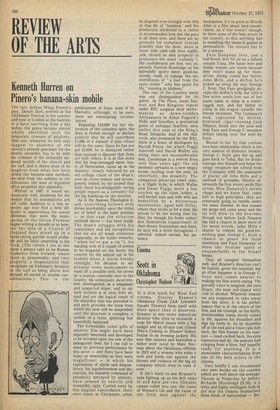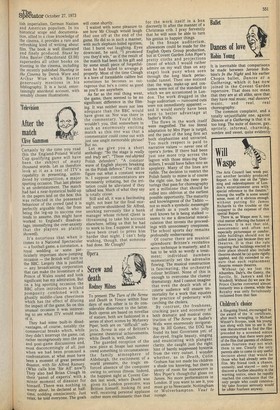Cinema
Scott in
Oklahoma a
Christopher Hudson
In a thin week for West End cinema, Stanley Kramer's Oklahoma Crude ('AA' Leicester Square Theatre) finds itself with more space than it deserves. Kramer is one more American director who tries to reconcile a nose for liberal issues with a big budget and an all-star cast (Guess Who's Coming to Dinner? Sidney Poitier in an evening jacket). His new film tautens and burnishes a rather poor novel by Marc Norman about the Oklahoma oilfields in 1913 and a woman who sinks a well and holds out against the threats and violence of the big oil company which tries to take it over.
It isn't hard to see Kramer's eyes lighting up as the drill sinks in and here are two filmable causes rolled into one: the cause of Women's Lib and the cause of the little man against the monopolies. It's as good as Woody Allen in a film abqut land conservation. As if this weren't enough, he hires some of the best actors in the country, so that anything lost in muddling the issues is gained in personalities. The mixture has to be a•winner.
Faye Dunaway then, and a half-breed, drill for oil on a hillock outside Tulsa. She hates men and thinks women are worse because they won't stand up for themselves. Along comes her fatter, John Mills, and a drifter he's picked up along the way, George C. Scott. Our Faye grudgingly accepts the drifter's help, but with a fine scorn sends him out of her warm cabin to sleep in a waterlogged tent, and her father to camp in his wagon outside the, fenced enclosure. The Company's men, captained by booted, bowlered, cigar-chewing Jack Palance, break into the area and beat Faye and George C senseless before taking over the well by force.
Bound to her by that curious love-hate relationship which is the very essence of dramatic tension, George C. Scott gets fed up and goes back to Tulsa. But he drinks courage into himself and helps the virago recapture her oilfield from the Company with the assistance of plucky old John Mills and a cartload of grenades. Shortly afterwards the first wintry smile flits across Miss Dunaway's severe visage and we know that, come hell or high principles, they are eventually going to tumble under the same blanket. In due course the props will come away and the oil will blow to the heavens, though not before Jack Palance has had a chance to show more of his mean streak, John Mills a chance to redeem his good-fornothing past, George C. Scott a chance to prove his loyal manliness and Faye Dunaway to show the frontier spirit is unquenchable in the female breast.
They all comport themselves well, and Kramer's direction can't be faulted, given the material, but as often happens it is George C. Scott who comes nearest to making the film worth seeing. The gravelly voice is resigned, the eyes bleary, the nose red-tipped with cold or alcohol. Whatever lessons we are supposed to take away from the story, it is his performance that is at the centre of the film, and his triumph, as the shifty, downtrodden tramp slowly comes to life, squares his shoulders and digs his heels in. As he shambles off at the end and a voice calls him back, the film freezes on his reaction — head cocked back, the eyes humorous and sly, the posture half cringing from a blow, half jauntily ready for anything. It is a memorable characterisation from One of the best actors in the cinema.
Very briefly I can recommend two new books on the cinema which are well above the average. Visions of Yesterday by Jeffrey Richards (Routledge £5.50), is a witty and highly intelligent look at the way the cinema dramatised three kinds of nationalism — Bri tish imperialism, German Nazism and American populism. In its historical scope and documentation, allied to a close knowledge of the cinema, it provides a rare and refreshing kind of writing about film. The book is well illustrated and finely produced. Stunt by John Baxter (Macdonald £3.50) supersedes all other books on stunting in the cinema, including the recently published Stunting in the ,Cinema by Derek Ware and Arthur Wise which Baxter generously mentions in his bibliography. It is a lucid, entertainingly anecdotal account, with sensibly chosen illustrations.



































 Previous page
Previous page